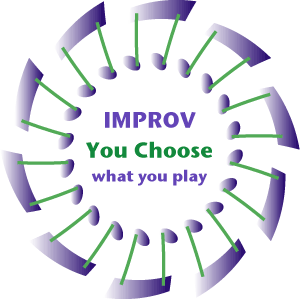Do you wish you could improvise?
Did someone tell you that you ought to try improvising? Did you pass up a chance to improvise with friends because you thought you couldn’t do it?
Improvising isn’t hard. You just have to dare!
You are improvising when you play something you just thought of, without seeing it written down. You can improvise by yourself, by playing a melody you invent as you play. You can improvise with other musicians, with or without an agreed-upon plan. Maybe all you contribute is one long note that helps the musical whole hang together.

What is free-style improvisation?
Free-style improv is permission to play anything you want. Once you accept that permission, you can use your musical ears to make choices and bring musical sense to your improvisations.
How is this different from jazz? Traditionally, jazz improvisers practice patterns and licks, in various keys. They learn classic tunes with chord changes and can play them from memory.
Then they improvise melodic lines and wide-ranging solos over the phrase structure of the original tune. These solos are usually harmonically related to the tune’s chord changes.
Jazz improvising is a fine thing and a great challenge to do well. It is worth practicing.
However, there are other approaches to spontaneous musical thought. You can start making creative improvisations right now. In your practice room.
Scroll down to the bottom for help in how to practice.
A bit of history
Beginning in the 1950s, progressive jazz musicians developed various styles breaking free of jazz conventions. The term free jazz encompasses many techniques, including free structure, deriving harmony from the improvised melody with no set chord changes, playing noise and using extended techniques. You can listen to the great musical experimenters like Ornette Coleman for improv ideas. It still feels like jazz when there’s a drum set and swing rhythms.
Avant-garde classical musicians were, and still are, experimenting with compositions that weren’t notated on a music staff. In the 1960s, concept composers like John Cage triggered a lot of interest in compositional designs based on chance or graphic scores. Written-out compositions could include extended sections where the performer improvised. Graphic scores might include some musical symbols, but often were artistic shapes that suggested musical direction. Text scores described musical processes that the musician interpreted more or less freely. Free-form, unscripted improvisation could include noise, environmental sounds, electronic processing, drones — pretty much any sound fit into someone’s improvisation.
Essence of free-style improvising
Free-style improvisation, which I encourage you to try, is wide open. Anything is legit, and the results are unpredictable. It becomes musical when you listen and develop your material with variety and balance. You, and your improvising partners, create structure as you go, by repeating and varying the musical material. Your improvs can be as harmonic and tonal or as out-there or noise-based as you want.
The most important thing is: Listen. What you play becomes your response to what you just heard. You’ve got to listen, and you’ve got to pause, create phrases, and leave space for other voices.
Then music happens!
How to improvise with other musicians
So, here is a very short list of guidelines for a group improv session:
- Listen.
- Be brave. Play with intention.
- Be collaborative. Listen to your improv partners and relate to what you hear. Let your musical gestures help the evolving piece of music develop.
- Listen more, and leave space for your partners to play.
Before you have a group, you can practice on your own.
Practicing Improvisation
How can you practice improvisation? First of all, just do it. Play something that is different from your usual warmup or the music on your music stand. Make something up — then consider whether you thought it was interesting. Then try it again and make it more musical and more interesting.
But, even though you can play anything, you’ll want to have techniques for creating a musical structure and coming up with new ideas. My “20 Improv Ideas” e-course provides those ideas for your daily music practice.
Get started improvising with “20 Improv Ideas”
My free “20 Improv Ideas” E-Course gets you started. It delivers 20 ideas via email, one every other day, to guide you.
You’ll get tips for exploring your instrument; for using music you already know; and for developing an idea into something interesting.
Read more about “20 Improv Ideas” — Then try it, and have some fun!
Get started today. Sign up for “20 Improv Ideas”.
Eighth note circle image by Sheet Music Note Vectors- Free | Free vector by Keepdesigning